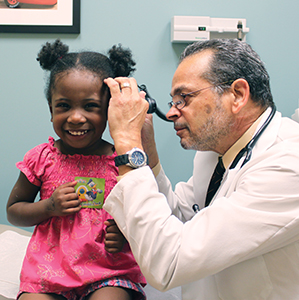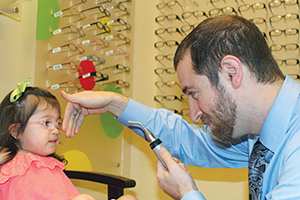By JULIE MINDA
When zip codes predict life spans, addressing disparity should be a central concern
NEW ORLEANS — To illustrate how profoundly disparity can impact people's lives — and how important it is for communities to address disparities — a speaker at a recent Ascension community health conference drew from his own experiences growing up in two different zip codes, both in metropolitan Washington, D.C.

Dr. Louis Bevrotte treats a pediatric patient at the Daughters of Charity Health Center — Carrollton in New Orleans.
As a child, Dwayne Proctor lived in the Anacostia neighborhood of the capital before moving with his mother about 25 miles away, to Fairfax, Va. In Anacostia, he said, jobs were scarce, violence and crime were prevalent, schools were failing and healthy food was hard to come by because there were no full-line grocery stores. In Fairfax, incomes were higher than in Anacostia, jobs more available, schools stronger and nutritious food plentiful at nearby grocery stores. Life expectancy was years higher in Fairfax, as compared with Anacostia, and these conditions persist today, said Proctor, who is a director and senior advisor at the Robert Wood Johnson Foundation.
"When zip codes can predict life outcomes, we have a problem," Proctor said. One solution, he said, is to refresh the community health system in the U.S. "We need a culture of health in America, so that we lead better lives — so that we can get and stay healthy. Good health ensures a better life."
He was among the couple dozen experts who shared their vision for an improved community health system and explored how to achieve it, during a three-day conference that St. Louis-based Ascension hosted for leaders of its local health facilities.
In setting the stage for the conference, Ascension President and Chief Executive Anthony Tersigni said, "With the pace of change accelerating, and with increasing challenges and opportunities (in health care), we want to focus on population health — to promote (disease) prevention and wellness. The best way to do this is through a community health strategy." He said that Ascension aims to become an integrated system of care that focuses on well care provided in the community rather than on sick care delivered in acute care facilities. Appropriately managing the care of populations of people in Ascension service areas is crucial to Ascension's strategy, he said, and community health approaches are necessary to do so successfully.
Roots of disparity
The "2015 Ascension Community Health, Equity and Inclusion Conference" drew more than 150 Ascension leaders to New Orleans last month; they represented many of the system's 1,500 locations in 23 states and the District of Columbia. Dr. Regina Benjamin, former U.S. surgeon general and current Ascension board member, moderated the event. Panelists included Proctor; Dr. Ronald Wyatt, medical director of the Joint Commission's division of health care improvement; and Dr. Gary Wiltz, chair of the board of the National Association of Community Health Centers. Speakers from within Ascension led discussions of practical aspects of community health work, including the use of data, research, outreach work and advocacy to support community health goals.
Benjamin said that it's necessary to address the social determinants of health in communities for health care providers' population health models to work. That is because those social determinants — such as income, education, housing, transportation, food access and job availability — have such a significant impact on people's health. She said that, as a community physician, she has learned that most of her working-class patients "had problems that a prescription pad can't solve."
By focusing on prevention of problems, and by taking a holistic perspective on community health, she said, communities can help stop many diseases before they start.
Knock before entering
Wyatt, of the Joint Commission, illustrated Benjamin's point by describing a young, low-income mother he encountered while working on a project in Atlanta. When asked why she fed her children canned foods with lots of preservatives rather than fresh produce, the woman told Wyatt that to get fresh food, she would need to ride the bus to the grocery store with her three small children, buy several bags of groceries and transport those groceries back, on the bus, getting home after dark, in an unsafe neighborhood, with the children in tow. She bought canned goods using her food stamps at a convenience store.
Wyatt said the woman's predicament demonstrates how community variables can prevent people from making healthful choices.
To understand what those barriers to health and healthy choices are, health care providers and community organizations must become intimately familiar with the localities they're serving, he said. "You need to understand my neighborhood and culture and streets, and I need to understand yours. And, you need to knock on my gate, before you can come in," he added, to emphasize the need to be invited into neighborhoods, rather than barging in.
Equity trumps equality
Proctor told the audience that community leaders and organizations, health care providers included, need to band together to make health a shared value and priority. After together learning what major health concerns exist in a community, they need to partner to address those concerns. He noted that community leaders must be aware there is a difference between giving everyone in a community the same thing (equality) and giving the people most in need the things that will help them most (equity). He said equity should be the goal.

Michael Griffin, left, Dr. Gary Wiltz and Dr. Regina Bejamin chat at the "Ascension Community Health, Equity and Inclusion Conference" in New Orleans. Griffin is president and chief executive of Daughters of Charity Services of New Orleans; Wiltz is chair of the board of the National Association of Community Health Centers; Benjamin is an Ascension board member and a past U.S. surgeon general.
Wiltz told conference attendees that community health centers should be part of the equation when communities pursue population health and community health strategies. Conceived 50 years ago during Lyndon Johnson's "war on poverty," community health centers are non-acute providers serving medically underserved areas. They are certified by the Health Resources and Services Administration and receive favorable "fair payment rates" under Medicaid and Medicare. The centers' governing board must have 51 percent representation by community members who are patients of the center. Many — specifically, those designated federally qualified health centers — are federally funded. Wiltz said that community health centers normally are deeply embedded in their local neighborhoods and thoroughly knowledgeable about the culture, lives and needs of their neighbors, and so they can be an invaluable resource when it comes to pursuing community health solutions.
New priority
In an interview with Catholic Health World, Dr. David Pryor, Ascension executive vice president and chief clinical officer, said Ascension is not pushing a one-size-fits-all model for pursuing community health in the communities its facilities serve. Rather, the system is urging its facilities to evaluate the way they are approaching health care delivery, to ensure community health is a priority, particularly in low-income areas.
Patricia Maryland, president of health care operations and chief operating officer of Ascension Health, added that addressing population health concerns will give people in communities served by Ascension facilities what they need to improve their health, which will lead to better health outcomes as well as a reduced cost to care for the individuals.
Pryor said that the population health approach, including the focus on community health, shifts health care dollars from the way they are currently allocated — often in a wasteful, reactive way — to a way in which they can be used to promote wellness and prevent disease.
He said the strategy, including the community health focus, will further Ascension's mission, which is in part to "deliver high-quality, low-cost care solutions for individuals and defined populations with special attention to those who are poor and vulnerable."
Pryor said, "If you believe health care is a right, and not a privilege, as we do, then disparities are unconscionable," and must be addressed.
| Ascension shares a New Orleans community health success story Ascension leaders attending the system's "Community Health, Equity and Inclusion Conference" here last month learned during a panel discussion how community health clinics are improving health care access, particularly in low-income areas of New Orleans. Panelist Michael Griffin, president and chief executive of Ascension's Daughters of Charity Services of New Orleans, explained how that ministry made the decision to become a federally qualified health center, or FQHC, despite the fact that "the world said it couldn't be done." Griffin told Catholic Health World that many experts erroneously assume Catholic facilities cannot comply with the requirement that FQHCs be majority controlled by community members, and provide required family planning services while also adhering to the Ethical and Religious Directives for Catholic Health Care Services. "Holding fast to our Catholic identity was paramount to our success," he said.  Dr. Seth Stanton examines a patient at the Daughters of Charity Health Center — Carrollton in New Orleans. When the Daughters of Charity congregation, through their Daughters of Charity Services organization, sold their hospital in New Orleans in the 1990s, they committed to continue to provide health services in Louisiana. They decided to establish community health centers to provide health care in the city's poorest neighborhoods. They opened the first center in 1997; it was destroyed by Hurricane Katrina in 2005. The Daughters of Charity opened a temporary site in 2008 and then a permanent location in 2010. That facility, and another Daughters of Charity community health center built in 2005 in Metairie, La., experienced escalating demand for their services. At the Metairie location, the spike was driven by a large influx of Hispanic people who had flocked to New Orleans to seek work rebuilding the city and had made their homes in Metairie and environs. Griffin explained to Catholic Health World that the clinics needed to cover and contain the cost of caring for impoverished patients who were uninsured or insured through Medicaid, since standard Medicaid reimbursements do not fully cover the cost of providing care. Griffin explained that the organization decided to pursue FQHC status, because those federally designated centers have expense and revenue advantages. FQHCs can purchase drugs at a low government-established rate, even for patients not insured through government payers. Also, Medicaid and Medicare pay enhanced reimbursement rates to FQHC providers to offset the cost of caring for the uninsured — rates that are at least double those paid to provider facilities not designated as FQHCs. FQHCs also can receive additional federal grants to subsidize the cost of caring for the uninsured. These benefits of FQHC status provide a significant financial boost enabling the facility to care for a needy community, Griffin said. Griffin told conference attendees during the panel discussion that when the Daughters of Charity considered the FQHC governance requirement that FQHC users hold the majority vote on the board, its leadership realized that having this level of community interaction could be beneficial. He asked: "Why wouldn't I want the users of my services" involved in guiding the health center? He said that the Health Resources and Services Administration regulations for establishing and operating FQHCs are extensive, including the need to use stringent bidding processes and to adhere to exacting quality and clinical outcome standards. The Daughters of Charity relied on consultants to ensure compliance. Griffin said HRSA has approved "many different models" of FQHCs. In addition to faith-based operations, he said these include collaborative partnerships, corporate, and public-ownership models, as well as models located at schools and public housing complexes. Daughters of Charity's community health centers achieved FQHC status in 2012. The organization now has eight — soon-to-be nine — community health centers around New Orleans, all part of the FQHC. While each clinic provides a different blend of services, together they offer primary, prenatal, pediatric, dental, behavioral health and optometric health care; pharmacy services; mobile health outreach; access to social services and support; and other offerings. The locations are all certified by the National Committee for Quality Assurance as patient-centered medical homes, which requires coordination of all aspects of care for patients, electronic medical records and disease registries and the use of a care team model, he noted. Griffin told Catholic Health Worldthat although FQHCs are required to provide access to family planning services, it is possible to do so and adhere to the Ethical and Religious Directives for Catholic Health Care Services. "We did our due diligence and figured out what works for us. We … already had a natural family planning program in place" that is compliant with the ERDs as well as with the HRSA guidelines for FQHCs. Daughters of Charity has memorandums of understanding with other providers in the community to provide, on a referral basis, services noncompliant with the ERDs. Those other providers make payment arrangements directly with the patients. "My message is, 'do not be deterred from the FQHC model,'" Griffin told Catholic Health World. |
Copyright © 2015 by the Catholic Health Association
of the United States
For reprint permission, contact Betty Crosby or call (314) 253-3477.